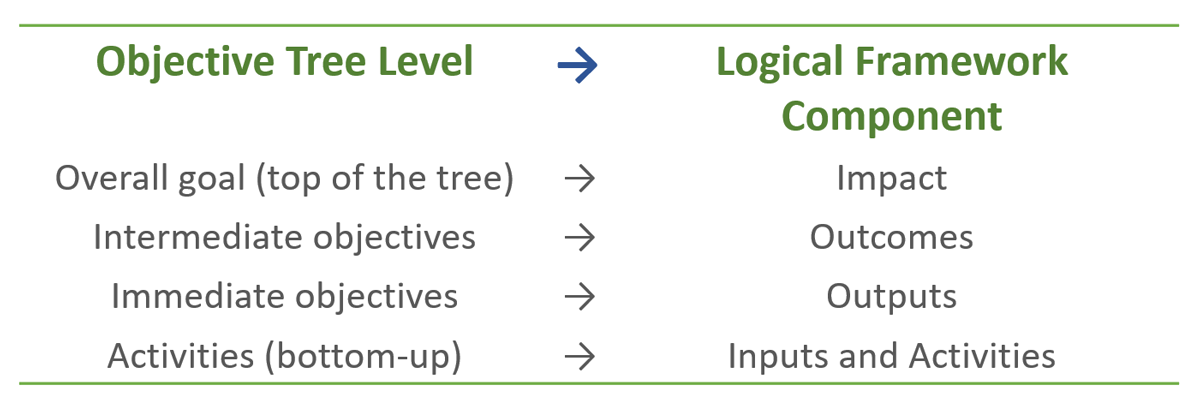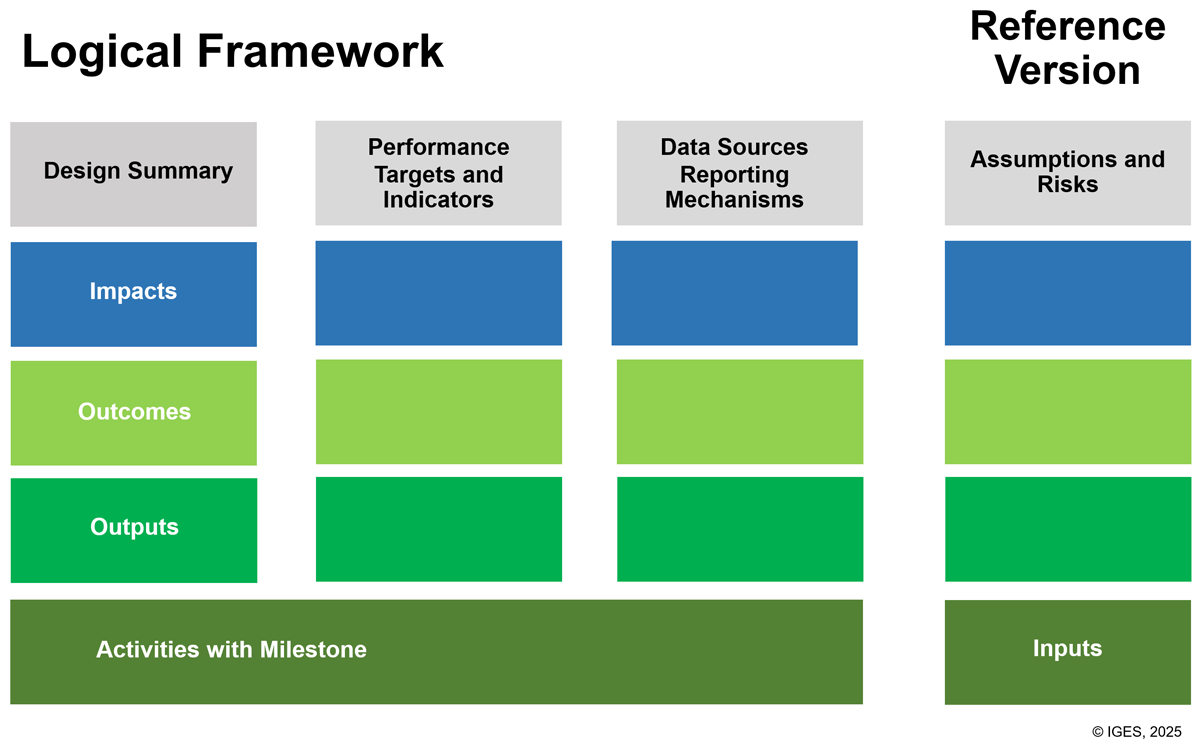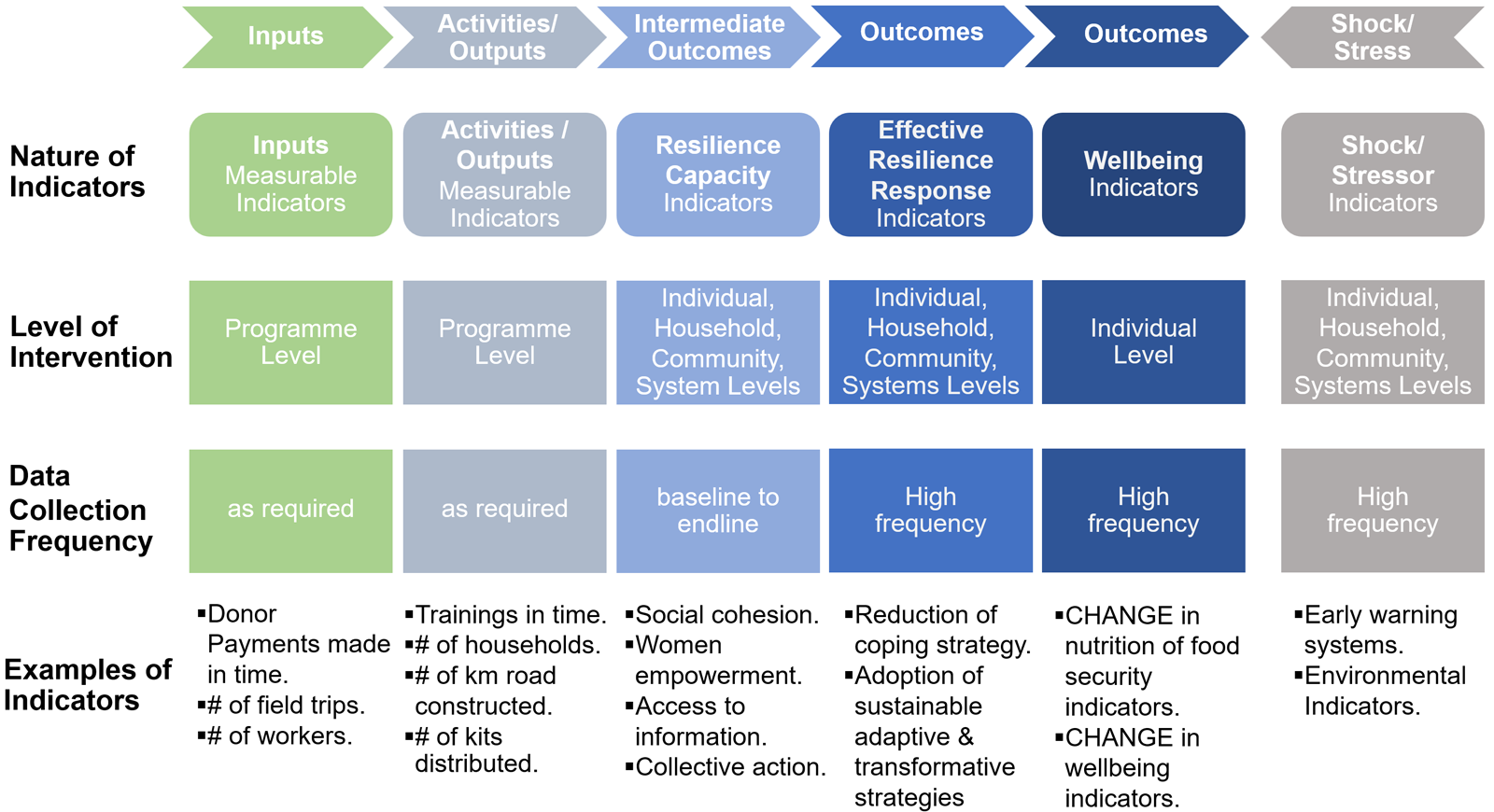The Logical Framework (also called LogFrame) is a central planning, implementation, and monitoring tool in the development of a GCF Concept Note. It provides a structured, results-oriented approach to project design, ensuring a clear alignment between the proposed activities and the intended climate change outcomes. The Logframe serves as a bridge between the problem analysis and the formulation of project strategies, translating objectives into measurable outputs, outcomes, and impacts. In the context of GCF, the Logical Framework is essential for demonstrating how the project or programme contributes to GCF investment criteria, particularly in terms of impact potential, paradigm shift, and sustainable development co-benefits. It helps define the project's theory of change, clarify assumptions, and outline indicators for tracking progress and evaluating success.
By systematically laying out the causal relationships between project inputs, outputs, outcomes, and the overall impact, the Logframe ensures coherence, transparency, and accountability. It also facilitates stakeholder engagement and supports adaptive project management by providing a basis for monitoring and evaluation throughout the project lifecycle. The Logical Framework is not a requirement for GCF Concept Note Stage, but it is still recommended for all projects. Logical Framework is the heart of the Project and will help convince GCF that the project will focus on a climate change challenge to that of a development challenge.
The Theory of Change (ToC) and the Logical Framework (LogFrame) are both essential tools in project design and evaluation, especially in results-based financing mechanisms like the GCF. While they are related and often used together, they serve different purposes and offer different levels of detail and flexibility. A helpful way to distinguish between the project's core planning documents is to view the Logframe as a structured management tool and the ToC as a strategic map of change. The following table summarizes the key differences between Theory of Change and Logical Framework.
| Aspect | Theory of Change (ToC) | Logical Framework (LogFrame) |
|---|---|---|
| Purpose | Explains the why and how of change; a narrative and visual roadmap of impact | Details the what of a project; a structured matrix for planning and M&E |
| Structure | Flexible, often visual diagram + narrative | Rigid matrix with rows (Impact → Outputs) and columns (Indicators, etc.) |
| Level of Detail | High-level causal reasoning, shows assumptions, pathways, and context | Operational and implementation-focused, with measurable targets |
| Focus | Understanding change processes, assumptions, and pathways | Monitoring and evaluation of specific results and activities |
| Usefulness | Good for stakeholder alignment and strategic thinking | Good for donor reporting, accountability, and performance tracking |
| Assumptions | Central to the model; explicitly mapped in pathways of change | Included in a separate column, often less detailed |
| Time Horizon | Long-term change over time | Project-specific timeframe |
Logical Framework Development
Developing Logical Framework from The Objective Tree
The Objective Tree and Logical Framework are two closely interrelated tools supporting a structured, result-based project design process that are used in the development of the GCF Concept Note. Together they help ensure that the proposed intervention is strategically sound, logically coherent, and aligned with GCF investment criteria. The Objective Tree is a conceptual tool that helps articulate what the project aims to achieve, while the Logical Framework is a planning and results tool that translates those aims into a clear, measurable action plan. Their integration is essential for the development of a coherent and compelling GCF Concept Note.
As detailed in the previous sub-chapter about Problem Tree, the process begins with a Problem Tree, which identifies the core climate-related problem, its causes, and effects. These are then rephrased as a positive goal or desired change and converted into an Objective Tree. The Objective Tree illustrates the hierarchy of objectives, showing how specific actions lead to broader development goals. The Objective Tree then becomes the foundation of the Logical Framework by translating its structure to a formalized results chain. Each level of the Objective Tree maps onto a component of the Logical Framework. The process of converting an Objective Tree into a Logical Framework is illustrated below:

This structured relationship ensures that the project's logic is consistent, making it easier to define measurable indicators, verify assumptions, and identify risks.
Logical Framework Format
The Logical Framework is also called “Project Framework”, “LogFrame”, “Project Decision Matrix”, “Results Framework”, or “Design and Monitoring Framework”. The overall goal, objectives, and activities identified in the Objective Tree should be used to populate the Logical Framework. Figure 5.3 provide a standard diagram for the Logical Framework and includes four columns (Design Summary, Performance Targets, Monitoring Mechanisms, and Assumptions and Risks) and five rows (Goal, Purpose, Outputs, Activities, Inputs). Note that hierarchical “logical” relationships appear vertically and horizontally, linking all 20 frames which gives this matrix its name. Figure 5.4 offers a more detailed overview of a Logical Framework when filled in with hypothetical indicators. In the illustrated framework, the inputs allow activities to be carried out (how?) that will deliver project outputs (what?), which in turn will meet the immediate purpose/outcomes of the project (how do we know?) and contribute to the longer-term goal/objective (why?).
Integration of Paradigm Shift
The overall objective of the GCF is to achieve a paradigm shift towards low carbon and climate resilient development pathways. To achieve this, the design of funded activities must be ambitious and strategically prioritize long-term, systemic change. Project proponents should ensure that their Funding Proposal describes a long-term vision through its Theory of Change and details how this can be achieved through short-, medium- and long-term changes in the LogFrame, including by supporting systemic shifts through strategic investments in regulatory and policy actions that have the potential to change behavior in markets and economies beyond one-off investments.
To effectively include a paradigm shift in the development of a Logical Framework (LogFrame) for a Green Climate Fund (GCF) Concept Note, you will need to embed transformational change across the project design, outputs, outcomes, and impact levels. GCF emphasizes funding initiatives that catalyze low-emission and climate-resilient development pathways, so your LogFrame must clearly demonstrate how your intervention contributes to that broader transformation. Below is a step-by-step guide on how to incorporate paradigm shift considerations into your Logical Framework.
Understand GCF’s Definition of a Paradigm Shift
GCF defines a paradigm shift as a fundamental transformation of economies toward low-emission and climate-resilient development. Key characteristics include:
- Scale: large-scale impact and replication potential
- Sustainability: lasting results beyond the project's duration
- Innovation: new approaches, models, or technologies
- Systemic Change: influence on policies, markets, or behaviors
Reflect the Paradigm Shift in the Impact and Outcome Levels
Impact Level (Long-term)
Write your impact in terms of a transformative climate goal aligned with GCF's Results Management Framework (RMF).
Example:
- Enhanced climate-resilient livelihoods for vulnerable rural populations
- Accelerated transition to renewable energy systems in [country/region]
- Ensure this impact aligns with GCF core indicators (e.g., increased resilience, reduced emissions).
Outcome Level (Medium-term)
Demonstrate institutional, behavioral, or systemic changes.
Example:
- Strengthened climate governance through inclusive policy reform
- Increased private sector investment in low-carbon technologies
- Include changes in capacity, practices, and systems that enable long-term shifts.
Design Outputs that Enable a Paradigm Shift
Outputs should be stepping stones toward a paradigm shift. They must enable scale-up or replication.
Examples:
- Capacity-building programmes institutionalized in government agencies
- Scalable climate-smart agriculture models piloted in multiple regions
- Climate financing mechanisms introduced and adopted by local banks
Include Paradigm Shift Elements in Activities and Assumptions
Activities: Ensure they reflect transformative actions (e.g., policy development, technology transfer, financial instruments).
Assumptions: Consider enabling factors for a paradigm shift (e.g., government commitment, private sector engagement).
Integrate Indicators that Reflect Transformational Change
Include both GCF core indicators and project-specific indicators that measure systemic impact.
Examples:
- Number of households adopting resilient practices (with potential for scale)
- Institutional changes enacted as a result of the project
- Volume of private/public finance mobilized
Explain the Theory of Change in Support of a Paradigm Shift
Accompany your LogFrame with a Theory of Change that:
- Shows causal pathways from activities to paradigm shift outcomes
- Highlights leverage points (e.g., policies, market incentives)
- Discusses sustainability and replicability
Support with Environment Measures
Document actions in the LogFrame that:
- Remove policy or financial barriers
- Engage stakeholders (especially vulnerable groups)
- Build national ownership
Review GCF Paradigm Shift Potential Criteria
Ensure alignment with the GCF’s Investment Criteria Indicators on “2.2 Paradigm Shift Potential”,
including:
- Potential for scaling up and replication
- Contribution to the creation of enabling environments
- Innovation
| Level | Example of Statement | Paradigm Shift Relevance |
|---|---|---|
| Impact | "National economy transitions to low-carbon agriculture" | Systemic transformation |
| Outcome | "Widespread adoption of climate-smart practices" | Behavior change and scalability |
| Output | "Innovative extension services developed and scaled" | Innovation and enabling environment |
| Activities | "Develop and pilot climate-smart extension curricula" | Builds institutional capacity |
When developing a GCF Concept Note, it is also essential to prioritize GCF sectoral paradigm shifting pathways1 and identify the contributions that the project can make at the ground level towards the Nationally Determined Contributions (NDCs) (of a respective country or countries) and to the GCF Strategic Plan 2024 – 20272. To effectively include a paradigm shift in the development of a LogFrame for a GCF Concept Note, the developer needs to embed transformational change across the project design, outputs, outcomes, and impact levels. GCF emphasizes funding initiatives that catalyze low-emission and climate-resilient development pathways, so the LogFrame must clearly demonstrate how your intervention contributes to that broader transformation.

Below are key points in integrating a paradigm shift into the LogFrame.
Table 5.4 also provides an example of a brief statement and illustrates the relevance of the statement to the paradigm shift.
GCF defines a paradigm shift as a fundamental transformation of economies toward low-emission and climate-resilient development. According to the GCF, paradigm shifts feature several key characteristics:
- Scale: large-scale impact and replication potential.
- Sustainability: lasting results beyond the project's duration.
- Innovation: new approaches, models, or technologies.
- Systemic Change: influence on policies, markets, or behaviors.

Source: IGES (based on Figure 5.3)
To reflect the paradigm shift in the impact and outcome levels of the LogFrame, write the impact level (long term) in terms of transformative climate goals aligned with GCF Sectoral Guides’ Summaries (GCF Sectoral Guides’ Summaries, 2022). In addition, write the outcome level (medium term) as demonstrative institutional, behavioral, or systematic change. Include changes in capacity, practices, and systems that enable long term shifts. To help guide the project developer, GCF provides a few examples of impact level and outcome level statements as follows:
- Impact level (long term) statements
- Enhanced climate-resilient livelihoods for vulnerable rural populations.
- Accelerated transition to renewable energy systems in a specific country or region.
- Outcome level (medium term):
- Strengthened climate governance through inclusive policy reform.
- Increased private sector investment in low-carbon technologies.
To design outputs that enable the paradigm shift, outputs should be written as stepping stones toward the paradigm shift. They must enable scale-up or replication. To help guide the project developer, GCF offers a few examples as follows:
- Capacity-building programmes institutionalized in government agencies.
- Scalable climate-smart agriculture models piloted in multiple regions.
- Climate financing mechanisms introduced and adopted by local banks.
When including paradigm shift elements in activities and assumptions, ensure that activities and assumptions reflect transformative actions. These actions can be, but are not limited to, policy development, technology transfer, or financial instruments. For assumptions, consider enabling factors for a paradigm shift. The enabling factors can be, but may not be limited to government commitment or private sector engagement.
When integrating indicators that reflect transformational change, it is recommended that both GCF core indicators and project-specific indicators be included to measure systemic impact. To help guide the project developer, GCF offers a few examples as follows:
- Number of households adopting resilient practices (with potential for scale).
- Institutional changes enacted as a result of the project.
- Volume of private/public finance mobilized.
When explaining the Theory of Change to support a paradigm shift, it is recommended that the LogFrame be accompanied with a Theory of Change (ToC). The relationship between the LogFrame and ToC should cover the following aspects:
- Shows causal pathways from activities to paradigm shift outcomes.
- Highlights leverage points (e.g., policies, market incentives).
- Discusses sustainability and replicability.
In addition, provide support by adding environment measures. These measures can be documented or explicitly included in the LogFrame, and can:
- Remove policy or financial barriers.
- Engage stakeholders (especially vulnerable groups).
- Build national ownership.
Lastly, it is beneficial for the project developer to review GCF paradigm shift potential criteria to ensure alignment with the GCF Sectoral Guides’ Summaries (GCF Sectoral Guides’ Summaries, 2022). Reviewing the paradigm shift allows the project developer to include several of the following points in the project Concept Note/proposals, including:
- Potential for scaling up and replication.
- Contribution to the creation of enabling environments.
- Innovation.
| Level | Example of Statement | Paradigm Shift Relevance |
|---|---|---|
| Impact | National economy transitions to low-carbon agriculture | Systemic transformation |
| Outcome | Widespread adoption of climate-smart practices | Behaviour change and scalability |
| Output | Innovative extension services developed and scaled | Innovation and enabling environment |
| Activities | Develop and pilot climate-smart extension curricula | Builds institutional capacity |

